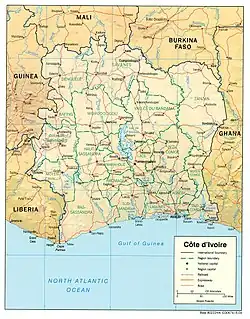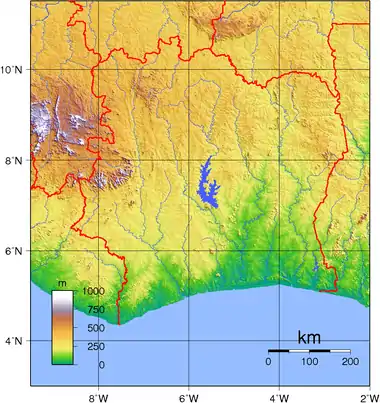  | |
| Continent | Africa |
|---|---|
| Region | Sub-Sahara |
| Coordinates | 8°0'N, 500'W |
| Area | Ranked 90th |
| • Total | 78,699 km2 (30,386 sq mi) |
| • Land | 4.89% |
| • Water | 95.11% |
| Coastline | 590 km (370 mi) |
| Borders | Total land borders: 3,458 km (2,149 mi) Liberia: 778 km (483 mi) Ghana: 720 km (450 mi) Guinea: 816 km (507 mi) Burkina Faso: 545 km (339 mi) Mali: 599 km (372 mi) |
| Highest point | Mont Nimba 1,752 m (5,748 ft) |
| Lowest point | Gulf of Guinea 0 m/ft (sea level) |
| Longest river | Bandama River |
| Largest lake | Lake Kossou |




Ivory Coast (Côte d'Ivoire) is a sub-Saharan nation in southern West Africa located at 8 00°N, 5 00°W. The country is approximately square in shape. Its southern border is a 515 km (320 mi) coastline on the Gulf of Guinea on the north Atlantic Ocean. On the other three sides it borders five other African nations for a total of 3,458 km (2,149 mi): Liberia to the southwest for 778 km (483 mi), Guinea to the northwest for 816 km (507 mi), Mali to the north-northwest for 599 km (372 mi), Burkina Faso to the north-northeast for 545 km (339 mi), and Ghana to the east for 720 km (447 mi).
Ivory Coast comprises 322,463 km2 (124,500 sq mi), of which 318,003 km2 (122,780 sq mi) is land and 4,460 km2 (1,720 sq mi) is water, which makes the country about the size of Germany.
Maritime claims
Ivory Coast makes maritime claims of 200 nautical miles (370 km) as an exclusive economic zone, 12 nautical miles (22 km) of territorial sea, and a 200-nautical-mile (370 km) continental shelf.
Terrain and topography
Ivory Coast's terrain can generally be described as a large plateau rising gradually from sea level in the south to almost 500 m (1,640 ft) elevation in the north. The nation's natural resources have made it into a comparatively prosperous nation in the African economy. The southeastern region of Ivory Coast is marked by coastal inland lagoons that starts at the Ghanaian border and stretch 300 km (186 mi) along the eastern half of the coast. The southern region, especially the southwest, is covered with dense tropical moist forest. The Eastern Guinean forests extend from the Sassandra River across the south-central and southeast portion of Ivory Coast and east into Ghana, while the Western Guinean lowland forests extend west from the Sassandra River into Liberia and southeastern Guinea. The mountains of Dix-Huit Montagnes region, in the west of the country near the border with Guinea and Liberia, are home to the Guinean montane forests.
The Guinean forest-savanna mosaic belt extends across the middle of the country from east to west, and is the transition zone between the coastal forests and the interior savannas. The forest-savanna mosaic interlaces forest, savanna and grassland habitats. Northern Ivory Coast is part of the West Sudanian Savanna ecoregion of the Tropical and subtropical grasslands, savannas, and shrublands biome. It is a zone of lateritic or sandy soils, with vegetation decreasing from south to north.
The terrain is mostly flat to undulating plain, with mountains in the northwest. The lowest elevation in Ivory Coast is at sea level on the coasts. The highest elevation is Mount Nimba, at 1,752 metres (5,748 ft) in the far west of the country along the border with Guinea and Liberia.
Rivers
The Cavalla River drains the western border area of the Ivory Coast and eastern Liberia. It forms the southern two-thirds of the international boundary between Liberia and Côte d'Ivoire.
The Sassandra River forms in the Guinea highlands and drains much of the western part of the Ivory Coast east of the Cavalla River.
The Bandama River is the longest river in the Ivory Coast with a length of some 800 km (497 mi) draining the east central part of the country. In 1973 the Kossou Dam was constructed at Kossou on the Bandama creating Lake Kossou. The capital, Yamoussoukro, is located near the river south of the lake.
The Komoé River originates on the Sikasso Plateau of Burkina Faso,[1] and briefly follows the border between Burkina Faso and Ivory Coast before entering Ivory Coast. It drains the northeastern and easternmost portions of the country before emptying into the eastern end of the Ébrié Lagoon and ultimately the Gulf of Guinea in the Atlantic Ocean. Its waters contribute to the Comoé National Park.[2]
Climate
The climate of Ivory Coast is generally warm and humid, ranging from equatorial in the southern coasts to tropical in the middle and semiarid in the far north. There are three seasons: warm and dry (November to March), hot and dry (March to May), and hot and wet (June to October). Temperatures average between 25 and 32 °C (77.0 and 89.6 °F) and range from 10 to 40 °C (50 to 104 °F).
| Climate data for Abidjan, Cote d'Ivoire | |||||||||||||
|---|---|---|---|---|---|---|---|---|---|---|---|---|---|
| Month | Jan | Feb | Mar | Apr | May | Jun | Jul | Aug | Sep | Oct | Nov | Dec | Year |
| Record high °C (°F) | 35.0 (95.0) |
35.7 (96.3) |
34.9 (94.8) |
35.0 (95.0) |
34.9 (94.8) |
36.2 (97.2) |
34.0 (93.2) |
32.0 (89.6) |
32.1 (89.8) |
32.8 (91.0) |
35.0 (95.0) |
33.7 (92.7) |
36.2 (97.2) |
| Mean daily maximum °C (°F) | 30.5 (86.9) |
31.0 (87.8) |
31.1 (88.0) |
31.2 (88.2) |
30.4 (86.7) |
28.7 (83.7) |
27.4 (81.3) |
26.9 (80.4) |
27.6 (81.7) |
29.2 (84.6) |
30.5 (86.9) |
30.3 (86.5) |
29.6 (85.3) |
| Daily mean °C (°F) | 26.8 (80.2) |
27.7 (81.9) |
27.9 (82.2) |
27.7 (81.9) |
26.9 (80.4) |
25.8 (78.4) |
24.7 (76.5) |
24.5 (76.1) |
25.6 (78.1) |
26.8 (80.2) |
27.4 (81.3) |
27.0 (80.6) |
26.6 (79.9) |
| Mean daily minimum °C (°F) | 23.5 (74.3) |
24.6 (76.3) |
24.9 (76.8) |
24.9 (76.8) |
24.6 (76.3) |
23.7 (74.7) |
22.9 (73.2) |
22.1 (71.8) |
22.3 (72.1) |
23.6 (74.5) |
24.4 (75.9) |
23.8 (74.8) |
23.8 (74.8) |
| Record low °C (°F) | 14.7 (58.5) |
16.0 (60.8) |
19.0 (66.2) |
15.9 (60.6) |
18.5 (65.3) |
18.6 (65.5) |
17.1 (62.8) |
17.2 (63.0) |
15.2 (59.4) |
17.5 (63.5) |
19.5 (67.1) |
16.5 (61.7) |
14.7 (58.5) |
| Average rainfall mm (inches) | 16.3 (0.64) |
48.9 (1.93) |
106.7 (4.20) |
141.3 (5.56) |
293.5 (11.56) |
561.8 (22.12) |
205.7 (8.10) |
36.8 (1.45) |
80.5 (3.17) |
137.7 (5.42) |
143.3 (5.64) |
75.1 (2.96) |
1,847.6 (72.75) |
| Average rainy days (≥ 0.1 mm) | 3 | 4 | 9 | 11 | 19 | 22 | 12 | 8 | 11 | 14 | 16 | 9 | 138 |
| Average relative humidity (%) | 84 | 86 | 83 | 82 | 84 | 86 | 85 | 86 | 89 | 87 | 83 | 83 | 85 |
| Mean monthly sunshine hours | 183 | 212 | 226 | 210 | 192 | 117 | 115 | 121 | 141 | 202 | 225 | 208 | 2,152 |
| Source 1: Deutscher Wetterdienst[3] | |||||||||||||
| Source 2: Danish Meteorological Institute[4] | |||||||||||||
| Climate data for Yamoussoukro | |||||||||||||
|---|---|---|---|---|---|---|---|---|---|---|---|---|---|
| Month | Jan | Feb | Mar | Apr | May | Jun | Jul | Aug | Sep | Oct | Nov | Dec | Year |
| Mean daily maximum °C (°F) | 31.5 (88.7) |
33.5 (92.3) |
33.5 (92.3) |
32.9 (91.2) |
31.7 (89.1) |
30.1 (86.2) |
28.6 (83.5) |
28.5 (83.3) |
29.3 (84.7) |
30.1 (86.2) |
30.7 (87.3) |
30.1 (86.2) |
30.9 (87.6) |
| Daily mean °C (°F) | 25.2 (77.4) |
27.3 (81.1) |
27.6 (81.7) |
27.3 (81.1) |
26.5 (79.7) |
25.6 (78.1) |
24.5 (76.1) |
24.5 (76.1) |
24.8 (76.6) |
25.2 (77.4) |
25.5 (77.9) |
24.5 (76.1) |
25.7 (78.3) |
| Mean daily minimum °C (°F) | 18.9 (66.0) |
21.2 (70.2) |
21.8 (71.2) |
21.8 (71.2) |
21.3 (70.3) |
21.1 (70.0) |
20.4 (68.7) |
20.6 (69.1) |
20.4 (68.7) |
20.4 (68.7) |
20.3 (68.5) |
19 (66) |
20.6 (69.1) |
| Average precipitation mm (inches) | 13 (0.5) |
42 (1.7) |
108 (4.3) |
126 (5.0) |
155 (6.1) |
165 (6.5) |
88 (3.5) |
83 (3.3) |
170 (6.7) |
125 (4.9) |
36 (1.4) |
15 (0.6) |
1,126 (44.5) |
| Source: Climate-Data.org, altitude: 236m[5] | |||||||||||||
Crops and natural resources
Ivory Coast has a large timber industry due to its large forest coverage. The nation's hardwood exports match that of Brazil. In recent years there has been much concern about the rapid rate of deforestation. Rainforests are being destroyed at a rate sometimes cited as the highest in the world. The only forest left completely untouched in Ivory Coast is Taï National Park (Parc National de Taï), a 3,600 km2 (1,390 sq mi) area in the country's far southwest that is home to over 150 endemic species and many other endangered species such as the Pygmy hippopotamus and 11 species of monkeys.
Nine percent of the country is arable land. Ivory Coast is the world's largest producer of cocoa, a major national cash crop. Other chief crops include coffee, bananas, and oil palms, which produce palm oil and kernels. Natural resources include petroleum, natural gas, diamonds, manganese, iron, cobalt, bauxite, copper, gold, nickel, tantalum, silica sand, clay, palm oil, and hydropower.
Natural hazards
Natural hazards include the heavy surf and the lack of natural harbors on the coast; during the rainy season torrential flooding is a danger.
Extreme points
Extreme points are the geographic points that are farther north, south, east or west than any other location in the country.
- Northernmost point – the point at which the border with Mali enters the Bagoé River, Savanes District
- Southernmost point – Boubré, Bas-Sassandra District
- Easternmost point – unnamed location on the border with Ghana south-west of the town of Tambi, Zanzan District
- Westernmost point - unnamed location on the border with Liberia in the Nuon River west of Klobli, Montagnes District
See also
References
 This article incorporates public domain material from The World Factbook (2024 ed.). CIA. (Archived 2015 edition)[6]
This article incorporates public domain material from The World Factbook (2024 ed.). CIA. (Archived 2015 edition)[6]- This article uses information published in the World Almanac and Book of Facts (2006) as a reference.
- ↑ Rupley, Lawrence A.; Bangali, Lamissa; Diamitani, Boureima (2013). "Sikasso Plateau". Historical Dictionary of Burkina Faso. Lanham, Maryland: Scarecrow Press. p. 197. ISBN 978-0-8108-6770-3.
- ↑ Mepham, Robert (1991). IUCN Directory of African Wetlands. Pinter Pub. Ltd. ISBN 2-88032-949-3.
- ↑ "Klimatafel von Abidjan / Elfenbeinküste" (PDF). Federal Ministry of Transport and Digital Infrastructure. Retrieved 8 November 2016.
- ↑ "STATIONSNUMMER 65578" (PDF). Ministry of Energy, Utilities and Climate. Archived from the original (PDF) on 16 January 2013. Retrieved 8 November 2016.
- ↑ "Climate: Yamoussoukro – Climate graph, Temperature graph, Climate table". Climate-Data.org. Retrieved 2 September 2013.
- ↑ "CIA - the World Factbook -- Cote d'Ivoire". Archived from the original on 2004-11-24. Retrieved 2004-11-27.
